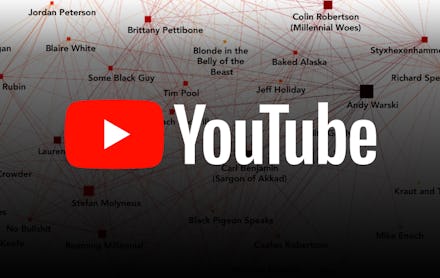How YouTube communities are creating “pathways of radicalization” toward white supremacist ideas

Certain tactics have become popular among the world’s growing legion of YouTube stars to build massive followings and show up in your recommended videos. Appearing on the channels of likeminded influencers and posting personal growth confessionals are just a couple of techniques found in YouTube communities for subjects like beauty, gaming and everyday vlogging. Now, white nationalists, fringe conservatives and various members of the far right have used such techniques to create a community of their own.
A new study from research firm Data & Society that charts the influence of 65 players in this community calls the faction the Alternative Influence Network. By using the techniques of social media influencers — trading credibility and accuracy for relatability — members of this group have created a news ecosystem where mainstream conservatives act as a sort of gateway drug toward extreme anti-feminism, nativism and overt white nationalism.
“What influencers do on YouTube and Instagram is building devoted followings by speaking directly to fans, revealing details of there lives and becoming micro-celebrities,” Rebecca Lewis, the author of the report, told Mic by phone on Tuesday. “And based on that trust and influence, they sell products. We see people using those tactics in this network — but what they’re selling their audience is reactionary ideologies.”
The study was conducted by Data & Society, a New York City-based research institute which publishes studies on the impact of technology on culture and politics. The team behind this study of far-right YouTube collected the data by hand, sifting through videos to map the network of reactionary YouTube personalities and their inadvertent allies.
The stars of the AIN use all the tactics typical of social media influencers. Right-wing personalities share personal growth testimonials about their about political radicalization and appear in each others’ videos to cross-promote one another. They hash out interpersonal beefs, have public falling-outs and publicized reunion events. They even have Instagram-ready celebrity couples.
The most important aspect of this network, however, is the way in which it leads viewers from mainstream topics, pundits and political celebrities towards avowed white nationalists and reactionaries.
The AIN includes everyone from mainstream conservatives like Ben Shapiro and Candace Owens, independent journalists like Tim Pool and Infowars’ Paul Joseph Watson to white nationalist celebrities like Richard Spencer and Red Ice TV’s Lana Lokteff. The study’s list also includes activists, journalists and members of what the New York Times glowingly called the “Intellectual Dark Web,” a name given to a group of very famous reactionary conservatives who rail against “multiculturalism” and claim that they’re persecuted by the left.
The members of the AIN aren’t all right-wing, or even necessarily self-identified conservative. But as the below chart indicates, the network of guest appearances and mutual promotions creates pathways on the web, so that in just a few clicks, a viewer can veer from rants about campus feminists to videos about debunked racism pseudoscience and white nationalist politics.
Shapiro has become one of the country’s most popular conservative commentators. He has particular appeal on platforms like YouTube, where his college talks are cut together in compilations with titles such as “Ben Shapiro DESTROYS Every College Snowflake.” The Data & Science report shows that, while Shapiro is not a white nationalist, his network of relationships on YouTube put him a single degree of separation away from Richard Spencer, one of the country’s most famous white nationalists.
One click away from Shapiro is popular host is David Rubin, a former host for the progressive, digital native Young Turks network who “left the left” to host an interview show, which now has over 820,000 subscribers. Many of his guests are mainstream personalities, like Shapiro himself, or billionaire investor Peter Thiel. Yet when one clicks through to his interview on “Race & IQ” with YouTuber Stefan Molyneux, one does not only find a discussion of whether black people have smaller brains than white people, but also a litany of recommended videos about how black people are innately less intelligent than whites.
Zeynep Tufekci, a Turkish researcher and an associate professor at the University of North Carolina at Chapel Hill, noticed this trend in March, and wrote in the Times that YouTube and other social media platforms allow conspiracy theories and insidious beliefs to thrive by exploiting the human desire to click through to misinformation that has been repackaged as subversive truths. She called YouTube “the great radicalizer.”
“As we click and click, we are carried along by the exciting sensation of uncovering more secrets and deeper truths,” Tufekci wrote. “YouTube leads viewers down a rabbit hole of extremism, while Google racks up the ad sales.”
Lewis acknowledges the role that YouTube’s recommendation engine plays a role in driving traffic to extremist content. But she notes is that radicalization on YouTube isn’t just a “fundamentally technical problem” but is “also a fundamentally social problem.” It’s not just that YouTube’s algorithms automatically usher viewers along from the mainstream ideas into white supremacist propaganda, but that mainstream voices knowingly become gateways to racism and extreme misogyny.